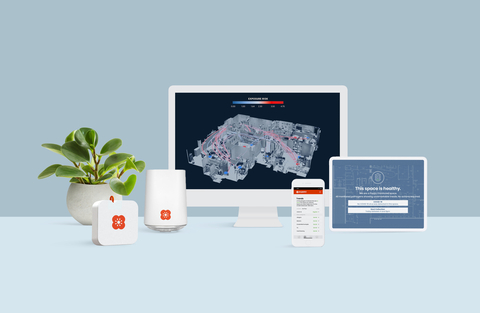SAN FRANCISCO– Poppy Health, providers of the world’s most advanced Air Monitoring system for indoor air safety, today announced the completion of an initial pilot project in partnership with Primary.Health, provider of software and services for large-scale testing and vaccinations, to test indoor air at California schools. During the pilot, Poppy’s Air Monitoring System was deployed by Primary.Health across four schools in the Bay Area over five weeks between May 9 and June 17, 2022. The goal of the pilot was to leverage indoor health data gathered by the Poppy system to determine if existing COVID-19 testing protocols were efficient in mitigating the spread of the illness in schools. Results from the pilot show the potential for classrooms to be safer for students and educators if ventilation performance is measured, indoor air safety is appropriately monitored, and corrective measures are taken based on the actionable insights delivered by the Poppy system.
The Poppy system used in the pilot provides quantitative air clearance data and diagnostic scanning to reveal how virus particles move through the air in each room, exposing hotspots and transmission pathways that pose great risk. The pilot allowed Poppy to:
- Measure ventilation performance against California state guidelines
- Evaluate the effectiveness of current ventilation mitigation investments
- Provide a plan on how to improve and address issues
The pilot also confirmed the presence of COVID-19 in schools, indicating when the virus was present in the air.
“At Synergy School, the health and safety of our students and staff are of utmost importance. So when Primary.Health integrated Poppy into our safety program, it made perfect sense. Poppy’s air monitoring system is an easy and unobtrusive way to visualize airflow and keep classrooms safe,” said Susanne DeRisi, librarian and COVID testing program coordinator, Synergy School in San Francisco. “Changes as simple as repositioning air filters can make a big difference.”
As schools transition from in-school to at-home antigen testing, monitoring of indoor air provides a reliable, cost-effective, and non-invasive way for administrators to keep a pulse on COVID-19, influenza, and other airborne illnesses that pose risks to students, teachers, and staff. Data from the Poppy system can also be used to prioritize schools and individual classrooms that are most in need of ventilation improvements across a district or state.
“With the SARS-CoV-2 virus continuing to mutate and new COVID-19 waves emerging, these pilots reinforce how school administrators and districts can affordably improve the safety of the air in schools and mitigate the spread of pathogens,” said Sam Molyneux, co-founder and co-CEO of Poppy. “Poppy can play a significant role by continuously measuring the effectiveness of ventilation systems, and revealing the presence of COVID-19 in classrooms. The time has come to look at the big picture and monitor how airborne viruses travel inside school buildings to prevent infectious outbreaks from taking hold.”
With one of the most ambitious indoor air exchange recommendations in the nation, 6-12 air changes per hour, many California classrooms don’t meet the recommendation, or have never been measured. According to researchers at Lawrence Berkeley National Laboratory, even recent HVAC retrofits may not deliver sufficient ventilation. This is why biosafety scanning and microbe monitoring systems are vital for ensuring healthy indoor environments for students, teachers, and administrators.
“As a partner to communities combating COVID-19, Primary.Health’s partnership with innovative companies like Poppy enable us to evolve our approach to combat airborne illnesses,” said Andrew Kobylinski, CEO and co-founder of Primary.Health. “Our collaborations allow us to introduce a new solution to public health leaders, schools, and communities who want to keep buildings safe and track the success of mitigation measures.”



